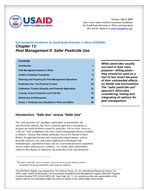The “safe pesticide use” paradigm, particularly as promoted by the agrochemicals industry, has been a common approach in attempting to mitigate the health problems caused by pesticides. All too often, however, “safe use” fails to emphasize the array of pest management choices available to farmers—choices that include pesticides, but are not limited to them. Rather, the approach focuses only on pesticide-related matters, such as pesticide selection, new and correct application technologies and methodologies, registration issues, and use of personal protective equipment such as masks and protective clothing (The latter, ironically, are too expensive for most resource-poor farmers and are intolerably hot and uncomfortable under tropical conditions). As a result, many stakeholders, whatever their degree of education, see pesticides as the crop protection method of choice—a “silver bullet”—when, in fact, there may be many less toxic alternatives that are never even considered.
This chapter provides guidance on maximizing the safety of pesticide use when such use is unavoidable. But no pesticide use should be considered before preventive and alternative measures have been examined and, where possible, adopted. It is in this light that USAID’s pesticide procedures were formulated. Before analyzing the risks and benefits of pesticide use, the procedures specify that project planners must (1) consider all reasonable IPM alternatives, and (2) describe all measures to be taken.
Resources and References
- Arnold, Edward (1992). The BMA Guide to Pesticides, Chemicals, and Health. London, UK: Edward Arnold.
- Hirsch, Brian, Carl Gallegos, Walter Knausenberger and Andrew Arata (2002). Programmatic Environmental Assessment for Insecticide-Treated Materials in USAID Activities in Sub-Saharan Africa. Washington, D.C.: USAID. http://pdf.usaid.gov/pdf_docs/PNACP696.pdf
- Davies, John E., V.H. Freed, and F.W. Whittemore (1982). An Agromedical Approach to Pesticide Management: Some Health and Environmental Considerations. Miami, FL: University of Miami School of Medicine.
- FAO (1988). Good Practice for Ground and Aerial Applications of Pesticides. Rome: Food and Agriculture Organization of the United Nations. http://www.bvsde.paho.org/bvstox/i/fulltext/fao13/fao13.pdf
- FAO (1995). Guidelines on Good Labelling Practice for Pesticides. Rome: Food and Agriculture Organization of the United Nations. http://www.fao.org/fileadmin/templates/agphome/documents/Pests_Pesticides/Code/Old_guidelines/label.pdf
- FAO (1990). Guidelines for Personal Protection When Working with Pesticides in Tropical Climates. Rome: Food and Agriculture Organization of the United Nations. http://paraquat.com/sites/default/files/FAO%20guidelines%20for%20PPE%20in%20Tropical%20Climates.pdf.
- FAO (1995). Pesticide Storage and Stock Control Manual. Rome: Food and Agriculture Organization of the United Nations. http://www.fao.org/docrep/V8966E/V8966e00.htm
- Food and Agriculture Organisation (FAO)/World Health Organisation (WHO) (2001). "FAO/WHO : Amount of Poor-Quality Pesticides Sold in Developing Countries Alarmingly High." Press release. WHO and FAO. Geneva. http://www.fao.org/WAICENT/OIS/PRESS_NE/presseng/2001/pren0105.htm
- Hodgson, E., and P. E. Levi, eds. (2002). A Textbook of Modern Toxicology, 2nd ed. Norwalk, Conn: Appleton & Lange.
- Leslie, A.R., and G.W. Cuperus (1993). Successful Implementation of Integrated Pest Management for Agriculture Crops. Florida: Lewis Publishers/CRC Press Inc.
- McConnell, R., F. Pacheco, and D.L. Murray (1992). "Hazards of Closed Pesticide Mixing and Loading Systems: The Paradox of Protective Technology in the Third World." British Journal of Industrial Medicine 49 (9): 615-620.
- Murray, Douglas L., and Peter Leigh Taylor (2000). "Claim No Easy Victories: Evaluating the Pesticide Industry's Global Safe Use Campaign." World Development 28 (10): 1735-1749. http://citeseerx.ist.psu.edu/viewdoc/summary?doi=10.1.1.168.4105
- Organisation for Economic Cooperation and Development (OECD) (1999). Report of the OECD/FOA Workshop on Integrated Pest Management and Pesticide Risk Reduction. Paris: OECD Environment Directorate. http://www.oecd.org/chemicalsafety/pesticides-biocides/2076763.pdf
- Overholt, W., and C. Castleton (1989). Pesticide User's Guide: A Handbook for African Extension Workers. African Emergency Locust/Grasshopper Project 698-0517. Bureau for Africa's Office of Technical Resources. Washington, D.C.: USAID.
- Pedigo, L.P. (1999). Entomology and Pest Management, 3rd ed. Englewood Cliffs, NJ: Prentice-Hall.
- The Africa Pesticide Product List Database
- Pimentel, D., and A. Grenier (1997). "Environmental and Socio-Economic Costs of Pesticides." In Techniques for Reducing Pesticide Use, D. Pimentel (ed.). New York: Wiley.
- Sine, C. (ed.) (2002). Farm Chemicals Handbook. Willoughby, OH: Meister Publishing Company.
- Tobin, Richard (1994). Bilateral Donor Agencies and the Environment: Pest and Pesticide Management. Washington, D.C.:USAID. http://pdf.usaid.gov/pdf_docs/PNABU947.pdf
- Treen, Tony (2009-2014).Pesticide Retailer Handbook Word (2MB)
- University of California-Davis (1998). Pesticide Safety: A Reference Manual for Private Applicators. Publication 3383.
- USEPA Office of Pesticide Programs. The Prior Informed Consent (PIC) Procedures: International "Right-to-Know." http://www.fluoridealert.org/pesticides/fluoroacetami.right-to-know.htm
- Wheeler, Willis B., ed. (2002). Pesticides in Agriculture and the Environment. New York: Marcel Dekker.
